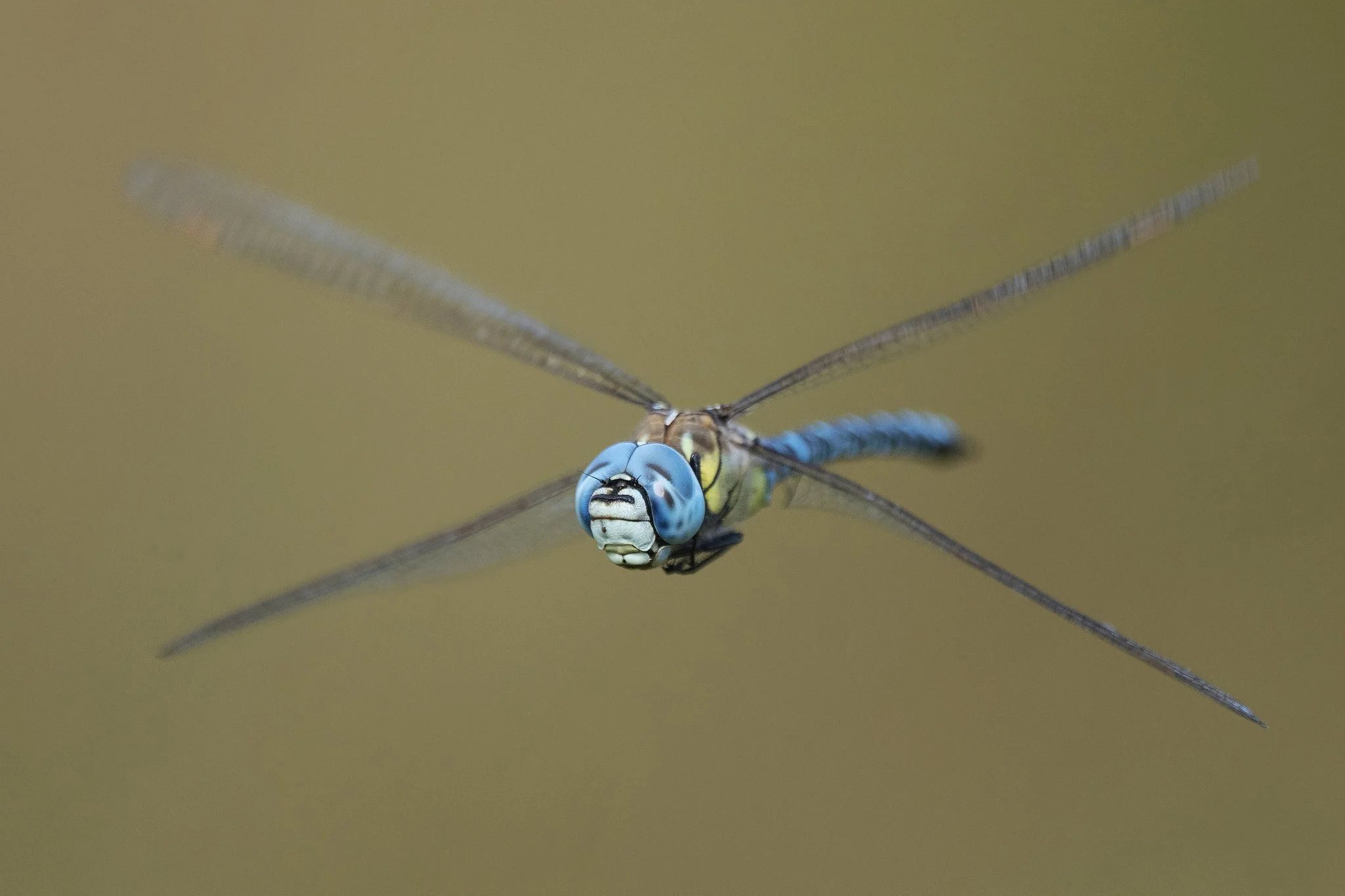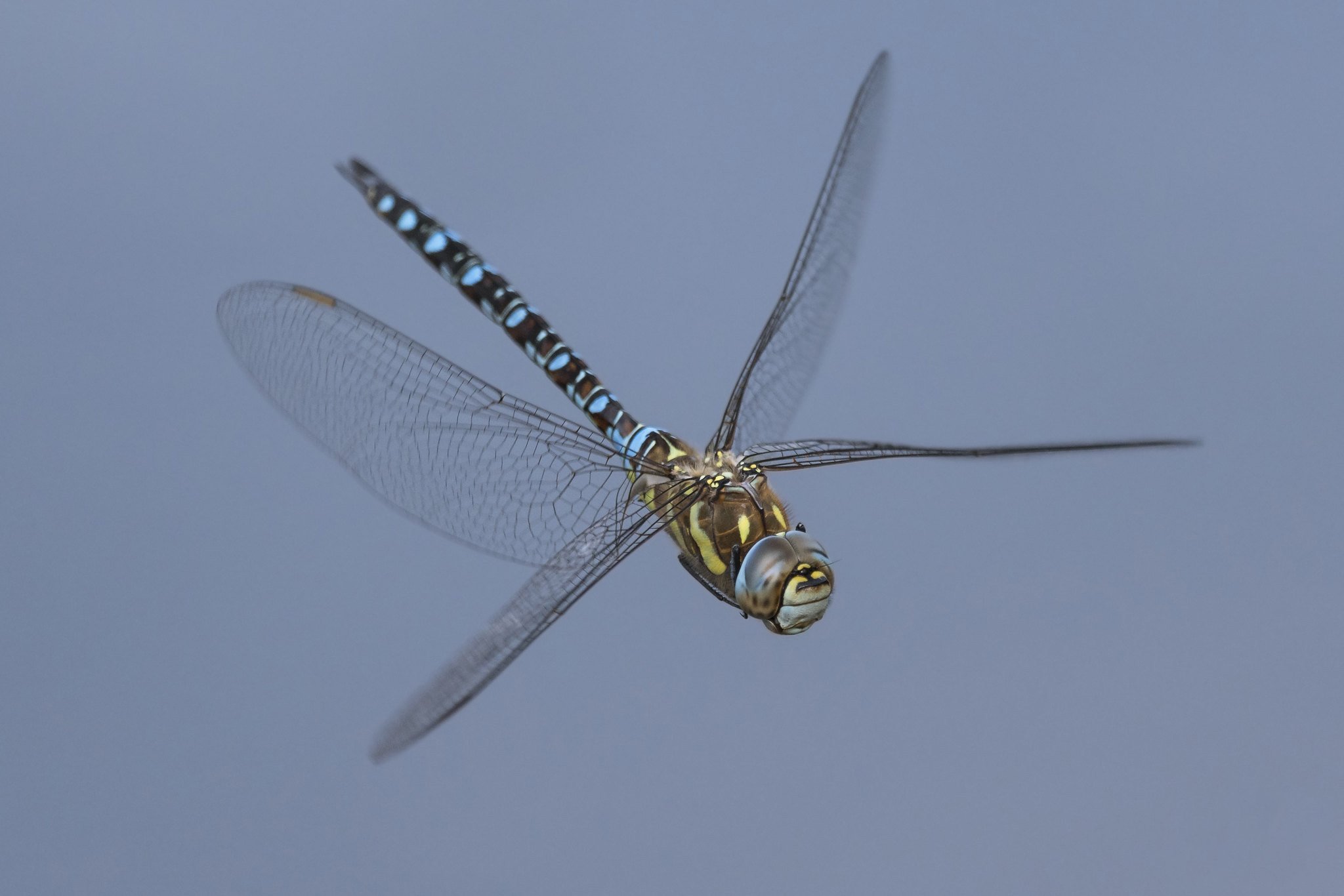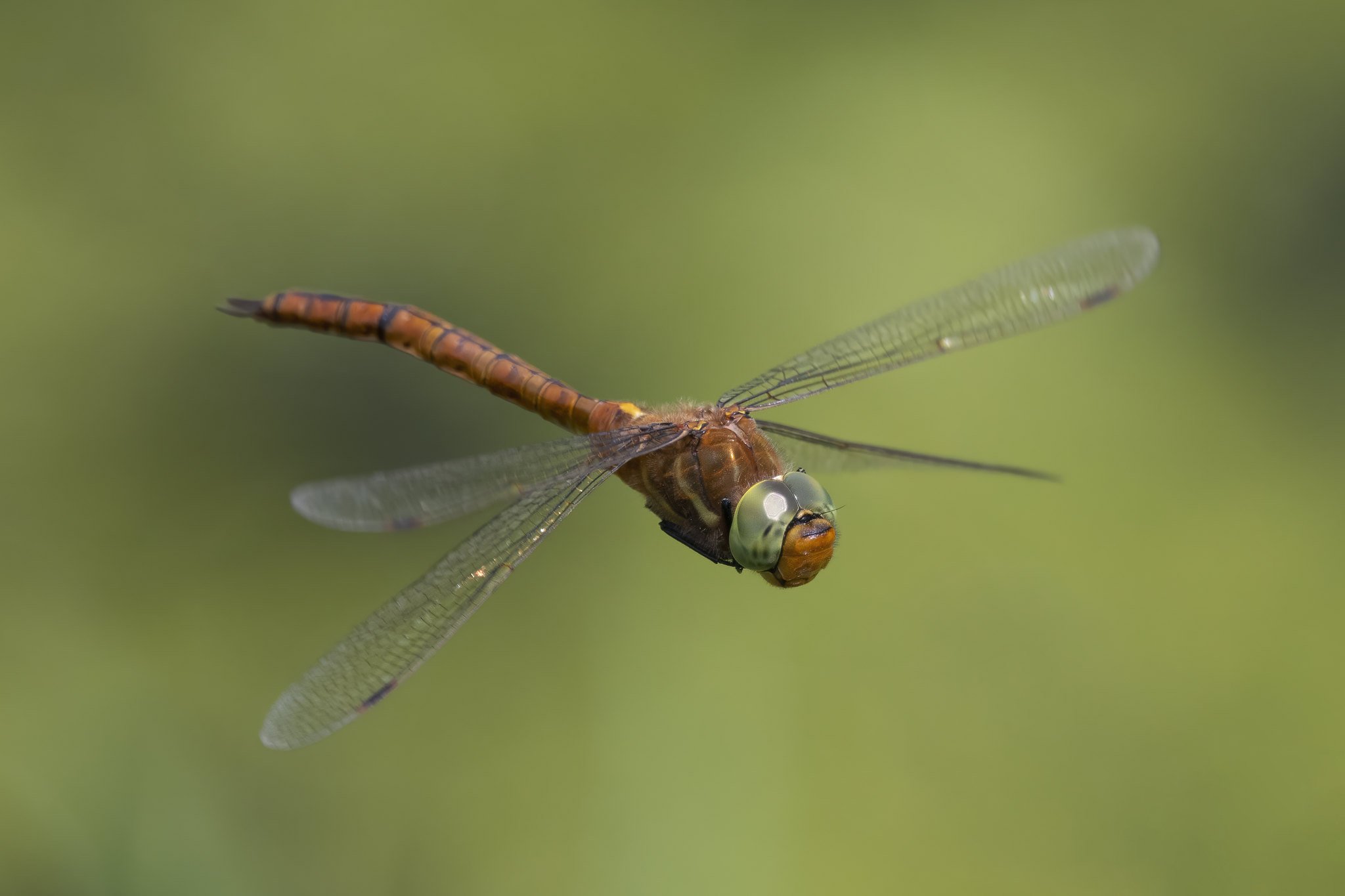Photographing Dragonflies in Flight
Migrant Hawker
With more and more species of dragonfly now emerging and Dragonfly Week commencing on the 1st of July until the 9th, I thought it was the ideal time to share a piece I wrote about photographing them in flight.
Introduction
Photographing dragonflies in flight is a form of wildlife photography that evokes emotions from both ends of the spectrum. It can be exhilarating one minute, frustrating the next and more often than not a confusing combination of the two. It's by no means an easy discipline and the fact that the success rate is so low compared to other types of wildlife photography, no doubt puts a lot of people off. This means that if you are into it, you are REALLY into it. When it comes to flight shots, there's no tentative toe dipping just to test the water, you need to be prepared to dive into the deep end and not look back. You might even question whether it's even worth bringing your swimming costume at all when I mention that you will be taking hundreds of photos in a session and the vast majority of those will end up getting deleted before they have a chance to leave the camera. The truth is, however, when you finally get that one shot in perfect focus where you can see all those individual facets in the dragonfly's eyes you immediately forget about the heartache that went before it. The satisfaction and sense of achievement you get from seeing that on the back of the camera is not something that is easily replicated in other forms of photography which is why you'll keep going back for more.
This guide is based on my own experience with photographing dragonflies in flight. Although I will be mentioning specific species that I have encountered and their behaviour, a lot of the principles can be applied or adapted to other species across the globe.
Field Craft
Field craft is something that goes without saying in regards to bird and other forms of wildlife photography but can easily get overlooked when photographing dragonflies in flight. When photographing wildlife, you can have the highest resolution, top of the range camera combined with the sharpest most expensive 600mm F4 lens money can buy. But if you can't get anywhere near your subject, the results are always going to pale into comparison to someone with cheaper gear but with the ability to stealthily get closer to their subject without being seen. Your camera can only resolve the detail that it is presented with.
Migrant Hawker - A wider shot, showing the dragonfly in its habitat.
If you shoot wildlife with a telephoto lens, there have probably been times when you wished you had more reach. Or in macro where you could have really done with a bit more magnification. The same applies when capturing dragonflies in flight. Being further away is a great way to start and you can get some fantastic wider habitat shots that way but if you want to get nice detailed frame filling dragonfly photos then you are going to need to get closer to the action.
Observing Behaviour
I cannot emphasise how important it is to observe and really familiarise yourself with your subject before you even pick up your camera. I'm also not talking about dragonflies in general when I say 'subject' I am referring to the individual species you are trying to photograph. The more you watch dragonflies the more you will notice how much their behaviour and routines differ from species to species. When the difficulty of photographing them is so high and hit rate so low, you want to do everything in your power to try and make the most of any advantage you can give yourself. One of the most important of these advantages comes from observing a species' behaviour. By identifying and predicting patterns you are able to put yourself in the best possible spot to hopefully push the odds a little more in your favour when it comes to successfully capturing the shot. This is easier said than done with some of them.
Emperor
The Emperor Dragonfly may be Britain's largest species but that doesn't make it any easier to lock onto. Given that they patrol over water, unless you want to go wading, your positioning will be governed and restricted somewhat by the bank of the river or lake. Much like the Brown Hawker they rarely slow down at all in flight and can be a real challenge to get close ups of, although Brown Hawkers do hunt over dry land as well as water. Having said this I have seen an Emperor hunting over a road before, a long way away from any water. I can’t imagine the greyish blue of the tarmac would confuse a dragonfly into thinking it was water but the raised banks either side of the road did give it a similar appearance to a river. It seemed to be hunting successfully and there weren’t any other dragonflies competing for food so it probably wasn’t such a bad idea. Finding a mate might be a bit tricky however.
Southern Migrant Hawker
Southern Migrant Hawkers will often hunt along dry ditches, giving you a bit more flexibility with your positioning. They also tend to follow quite a rigid and predictable flight path which means once you get into the perfect position you can often remain there and get plenty of opportunities for photos as they repeat their circuit. However, there is definitely a 'sweet spot' as far as distance is concerned. If you get too close, they will essentially re-calibrate the sat nav and start a slightly new amended route further away from you. So, you want to remain on the cusp of their patrol zone but not inside it.
Migrant Hawker
Migrant Hawkers are perhaps my most regularly photographed dragonfly and it's not surprising really. They have a wide distribution in a variety of habitats, close to water and further away, patrolling woodland edges well into autumn when most other species will have long gone. Unlike most dragonflies, the males are considerably less hostile to one another and can often be found hunting in large numbers. This can sometimes make photographing them seem like quite a daunting task as you don't know where to start. As long as you hone in and concentrate on one individual, they behave quite similarly to Southern Migrant Hawkers. Something else that these do, along with other hawkers, is periodically hover for a brief second. If they do this in the right spot for a photo, although it's only a very brief pause, it's normally the best opportunity you'll have to get a photo in focus. If there is a slight breeze, take note of wind direction as they tend to hover into it. This can help with where you choose to position yourself.
Southern Hawker
Southern Hawkers, in my experience, are a little trickier to photograph as they tend to be a bit less predictable. Although they are normally always 'hawking' along the edge of water, following a fairly consistent route they tend to do it in shorter spells, hiding up in between flights. This gives you less time to get your eye in before you have to stop and wait for its return to the air. They are also quite an inquisitive species and I have lost count of how many times I've sat down, reviewing photos, only to look up and see one staring at me hovering directly in front of my face.
Norfolk Hawker
Norfolk Hawkers have an altogether different hunting approach to the vast majority of species. Most other dragonflies tend to patrol a territory and will opportunistically pick off prey as and when they come into contact with it. Norfolk Hawkers on the other hand spend more time perched, waiting for prey to come to them, before taking to the air in order to grab it. If unsuccessful they will often still patrol a small area but will soon land again ready for the next attack. The trick here is to identify their favoured spot to land and position yourself near there. Knowing the spot they are coming back to gives you a chance to prepare yourself for a shot on their return. Many of the darters share this same hunting technique but don’t travel as far and will, more often than not, return to exactly the same spot each time. You can often get a lot closer to them when they are perched, than with Norfolk Hawkers, giving you more scope for a close up.
Equipment
I won't go into specifics when it comes to brands and products because that isn't in keeping with the nature of this guide. I'm more concerned with providing the kind of practical information that you won't find on a spec sheet or being discussed by every single photographer on YouTube. This, from my experience, is going to be more valuable than the most expensive kit (refer back to my earlier comment about expensive gear being no substitute for good field craft, if needed) That being said, there are definitely some useful things to take into consideration.
You don't need to have the latest and greatest camera with the most advanced autofocus system on the market, for a very good reason which I will discuss later on. In many ways the camera is the least important part of the equation (although I'm sure a lot of people will disagree with me on that one.) Something that will greatly help however is how many photos the camera is able to take per second. With flight photography a bit of luck can go a long way so if you are able to fire off 10 or even 20 frames per second you increase your chances of success considerably. You'll want to put your camera in high-speed burst mode in order to fully utilise the highest speeds your camera is capable of. Bear in mind, however, that without the right technique or understanding of your subject, you will simply end up with twice the number of photos to delete. So, if your camera isn't as rapid as others, don't let this discourage you. Instead, let it make you more determined to improve the aspects I discussed earlier which will help offset this shortfall.
Mirrorless cameras will often be capable of more frames per second than their DSLR counterparts due to the electronic shutter but this can leave the images susceptible to ‘rolling shutter’ effects. Dragonfly wings can appear warped in photos, to varying degrees, depending on the camera. Many high end mirrorless cameras now have such fast sensor readout speeds that rolling shutter isn’t really an issue and they see no need to include a mechanical shutter at all. For cameras further down the pecking order it’s a good idea to stick with the mechanical shutter to avoid any unnecessary distortion.
A camera that can perform well at a higher ISO will also be advantageous as you will be using high shutter speeds to freeze the fast-moving subject. Again this isn't the be all and end all because the vast majority of the time, dragonflies will be hunting in bright sunshine anyway. Plus, denoise software has come along leaps and bounds in the last few years so a slightly noisy image can be easily cleaned up in post.
You'll want a telephoto zoom or prime lens somewhere between 200 - 500mm. Any less and you will struggle to get close enough, irrespective of where you are placed in relation to the subject. Any more and the lens is going to be heavy/cumbersome which is not something you want when you are trying to photograph a fast-moving subject for an extended period of time. You also lose a bit of the connection between your eye and what you are photographing at the long end of the focal range. Almost like trying to shake hands with someone if the hand was on the end of a five-metre pole, where small movements are magnified and you lose precision with what you are doing. I wouldn't recommend using a tripod unless you really struggle hand-holding the lens you have, in which case it may not be the best one to use for this discipline. However predictable a dragonfly's flight path is it's still going to behave erratically and rapidly at times, particularly when it grabs prey. You just don't have time to be able to adjust a tripod whenever the dragonfly alters its height or trajectory and it will restrict where you shoot from as well as slow you down when you move spots.
Technique and Settings
Now I mentioned earlier about not needing a camera with the latest most advanced autofocus. In my experience autofocus is generally more of a hindrance than it is a help. Any cameras autofocus is going to struggle, however efficient it is, to lock onto something so small and erratic. This isn't a fault with the technology, it's just asking it to perform an impossible task. It's a big enough challenge to keep locked onto a fast-flying bird which, when compared to dragonflies, are large with a much more predictable trajectory. Dragonflies will almost always be flying around in locations where the background and the subject will be difficult for the autofocus system to distinguish between. This means the focus will constantly be hunting and the majority of the time will choose the more dominant background to lock onto. The autofocus won't struggle as much if you are photographing them from a distance but when it comes to getting close ups, it is next to no help at all. Another reason why autofocus is no use for getting close ups is that dragonflies can pick up on it from closer distances and it will stop them getting any closer. Now I could understand why this would happen if cameras still used active autofocus where an infrared beam is fired out from the camera to gauge distance. Dragonflies' eyes can see a much wider range of the colour spectrum than our own so it would make sense that they might be able to pick up on this beam. Modern DSLR and mirrorless cameras all utilise passive autofocus (phase and or contrast detection) which uses the light that comes into the lens without needing to send out an additional beam. It may, therefore, be the case that at close quarters the dragonflies can pick up on the sound of the autofocus system or even on the electronic pulses it may emit. Regardless of the science behind it, when I first turned the autofocus off during a session, there was a noticeable difference between how much closer the dragonflies came afterwards. Again, much like their behaviour, the dragonfly's sensitivity to the autofocus varies a lot between species. I found that Brown Hawkers kept their distance considerably whereas Southern Migrant Hawkers often took little to no notice.
Much like getting to know a species' behaviour and where to best place yourself to photograph it, getting confident with your lens will also help increase your efficiency and therefore chances of success. Learn its strengths and limitations in order to get the best out of it. If you are using a zoom lens, quite often they aren't as sharp at the long end of the range or with the aperture fully open. If their aperture isn't constant, you will also lose a valuable stop or two of light when you reach the longer end of the focal range. When it comes to getting frame filling photos, I would recommend finding a focal length that not only gets the best out of the lens optically but one that also gives you the best chance of being able to track your subject efficiently. If you stick with this focal length, it gives you the chance to get familiar with what kind of focussing distances you will have to manually adjust to in order to get the subject to fill the frame as much as possible. If you are constantly adjusting the zoom, the changes in focal length will also alter the focus distance. This means that with ever changing variables, there is nothing to fine tune around because nothing stays constant. If you stick with one focal length, or use a prime lens, through some trial and error, you'll learn the optimal focus distance at which to get the best close ups. In my case for instance, I have my focus set to 10 feet. Any further away, I won't be capturing sufficient detail and any closer, I risk cropping wing tips if the dragonfly isn't dead centre in the frame. I will then track the dragonflies' progress from a distance, with the camera but often with my left eye, given that everything will be out of focus through the camera. As the dragonfly gets closer to the point of focus, you'll start to see it in the frame. Just before it comes into focus, I'll press the shutter down to capture a short burst, before and after that point. Hopefully you will have a shot somewhere in between that has the eyes in perfect focus. It may be tempting to manually focus on the dragonfly from a distance and adjust accordingly as it gets closer but I find this a bit of a false economy. This method does mean that you will be able to see the dragonfly more clearly from a distance and it makes it easier to track as it comes closer to you. However, when it gets to that specific frame filling distance, the dragonfly will be travelling too quickly to follow manually and there is no way you will know where your predetermined frame filling focussing distance is to stop at. You've taken the time to learn the dragonflies behaviour, positioned yourself accordingly and know that it will enter into a spot that will fill the frame at your predetermined focussing distance. Why would you then go and move those goal posts every single time the dragonfly passes you in its circuit? All that does is make the dragonfly easier to track when you aren't photographing it, at the expense of when you are.
If you are taking a photo when the dragonfly is hovering, this is the one time when I may tap the autofocus because with it filling the frame, almost in focus already, the camera is more likely to be able to lock onto it quickly and accurately, without it hunting into the distance. I tend to use group area autofocus mode so the camera can choose from a small cluster of focus points to give it the best chance of locking on. This is where back button focussing comes into its own as you can switch between manual and autofocus instantly, without having to flick a switch on your lens. Having autofocus tied up with the shutter release rather than having its own designated button means this switch from one to the other is much more delayed and would come at the cost of getting the shot.
You'll want to open your aperture up as much as possible, bearing in mind what I mentioned earlier about the possible limitations of a lens, to let in as much light as possible. Auto ISO is also recommended as this is one less thing to worry about slowing you down. Just make sure you limit how high the auto ISO goes, based on how well your camera handles it and be sure to cap it before it gets to the point where the camera is no longer producing usable results. Shutter speeds can vary but as a guide I'm normally somewhere between 1000th to 2500th. If you still find you are getting blurry shots, you may want to increase the speed. Likewise, you can often get away with slightly slower speeds if you are trying to photograph a species when it hovers. Given that you will mostly be photographing on bright sunny days, it's a good idea to use a little bit of minus exposure compensation to prevent blowing out highlights. I tend to use -0.7 most of the time.
Final Thoughts
I appreciate that my photographic techniques might not be for everyone. The very fact that I'm trying to get frame filling shots means that I'm making an already difficult task even more complicated. I look at it as an inevitable development of curiosity. If you are taking hundreds of photos of any animal from a distance, there will come a time when this won't be enough. You'll want to challenge yourself to get even closer in order to uncover more detail and to mix things up a bit more. This is exactly how my interest in capturing dragonflies in flight has developed. I've taken hundreds of photos from a distance, using autofocus and the approach is pretty much the same as with birds in flight, only the subject is smaller and less predictable. Eventually I wanted to push things a bit further and attempt to capture a similar level of detail to what you might find in a static perched dragonfly photo. This is the point where I learnt things and developed techniques that were very much specific to photographing dragonflies in flight. This gave more value to writing a specific guide about it, knowing that I wouldn't simply be regurgitating information that could easily be found from various other sources. Even if the photographic techniques don't appeal, I can't emphasise enough just how important getting to know your subject and its habitat is. There are so many factors that are out of your control in dragonfly flight photography but if you do everything you can to make the most of the things you can control, you are more likely to put yourself in a spot that maximises your chances of success.
Southern Migrant Hawker








